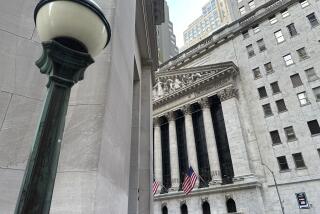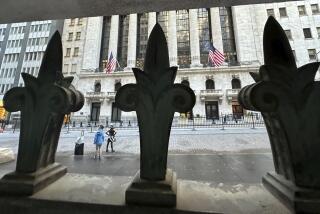What’s Next for Bonds : While Some Bail Out, Others Nibble at Higher Yields
The worst bond selloff in seven years has left many conservative investors in a quandary: Even as they count their losses, they’re also looking at extremely enticing yields on fixed-income investments.
If you can handle the risk, experts say, this could be a good time to shop for bonds and other income-producing investments.
The surge in market interest rates in the first quarter sharply devalued older fixed-rate bonds and competing investments such as utility stocks. That devaluation showed up most prominently in bond mutual funds, which hold more than $700 billion of Americans’ savings.
The average fund owning long-term U.S. government bonds tumbled 4.5% in price during the first quarter, according to fund-tracker Lipper Analytical Services in New York.
However, because government bond fund owners are earning interest at a 6.4% annualized rate, on average, the funds’ “total return”--interest earnings minus price loss--was a negative 3.2% for the quarter. In other words, interest earned during the three months helped offset some of the price decline.
Still, that may not be much consolation to former bank CD holders who converted those CDs to bond funds last year. Mutual fund companies fear that many new bond fund owners weren’t prepared to see any decline in their principal.
Indeed, most fund companies admit that their bond funds are experiencing net redemptions by shareholders for the first time in more than a year, as some spooked investors head for safer ground.
Over the last two days, however, interest rates appear to have stabilized. And many Wall Streeters continue to insist that rates have overreacted to worries about inflation rising in a strengthening economy.
“I think this bear market (in bonds) is at least three-quarters cooked” already, says William Gross, a veteran money manager at Pacific Investment Management Co. in Newport Beach.
The yield on the benchmark 30-year Treasury bond has rocketed from 6.35% at year’s end to 7.24% now. Shorter-term yields have risen even faster, in some cases. The five-year Treasury note yield, for example, is 6.42% now versus 5.20% at year’s end.
Even if inflation is slightly higher this year than the 3% annualized rate of recent years, current bond yields more than compensate for that risk, Gross and other Wall Streeters say. Inflation is the chief threat to bonds, because it erodes the value of their fixed returns.
Bond mutual fund managers, trying to put the best face on the first-quarter debacle, also note that the deep price declines of some types of bonds and bond funds exaggerated the actual level of selling in those markets.
Thinly traded tax-exempt municipal bonds, for example, suffered some of the biggest losses in the quarter. But that was less a function of investors’ desire to dump those bonds than of panicked brokerages’ arbitrary decision to mark down the prices of their bond inventories, regardless of buy or sell activity.
Susan Peabody, whose Alliance California Municipal bond fund has lost nearly 10% of its value since year’s end, said Wall Street’s perception is that “when you go through these phases in bonds, everyone’s a seller and there are no buyers.”
But in most bond sectors, the truth is that there have been few buyers in recent weeks, as interest rates began to rocket and many players stepped aside.
Now, however, yields have reached levels where some investors have at least begun to nibble again. And for good reason, bond pros say. “In many cases the calendar has been rolled back a year or a couple of years” in terms of yields available, says Theresa Havell, manager of the Neuberger & Berman Limited Maturity bond fund in New York.
What’s the best strategy for income-seeking investors now? Some ideas:
* Stay with bond funds of intermediate term (five- to 10-year maturities) or short term (one- to five-year). Their share prices decline less than long-term fund shares when market interest rates rise. And with the recent yield surge, intermediate- and short-term funds may pay as much or more than long-term funds did three months ago.
* Buy Treasury notes or bonds directly. If you’re a buy-and-hold investor, owning an individual Treasury bond means you can be sure of getting your money back at maturity, regardless of how its price fluctuates in the interim.
In contrast, because mutual funds are constantly trading bonds and have no set maturities, you may never recover a loss of principal in a fund if interest rates continue to rise in the years ahead. (However, a fund’s yield also rises with market rates.)
Banks or discount brokers can help you buy Treasuries, if you don’t have a broker. Or you can buy directly through the Federal Reserve.
* Look closely at tax-exempt muni bonds or funds. Because munis plunged so far in value in the first quarter, their yields now are particularly lucrative.
Peabody’s Alliance fund, which owns long-term California munis, yields about 5.85% now, up from 5.25% at year’s end. The current 5.85% tax-free yield is the equivalent of a 9% yield on taxable bonds (such as Treasuries) for a Californian in the 34.7% combined federal/state tax bracket. For higher-income taxpayers, that taxable equivalent yield is even higher.
* Look for bond “substitutes” whose yields have risen with market interest rates. Electric utility stocks, for example, have been hammered lower this year, sending their annualized dividend yields well beyond 6%, for the most part. Utilities may no longer offer the same kind of annual dividend growth as they did in the 1980s, but at current yields they may still prove to be decent long-term investments for risk-tolerant investors, some experts say.
* MARKETS SETTLE DOWN: For the first time in nearly two weeks, stocks and bonds did not take investors on an emotional roller coaster ride, with the Dow Jones industrial average posting a slight gain and the 30-year Treasury bond yield closing unchanged. D2
A Losing Quarter for Bonds
Rising market interest rates devalued older fixed-rate bonds in the first quarter, which means bond mutual fund owners saw their share prices fall. Here’s a look at the average price declines in key fund categories, compared with their average annualized yields.
Fund category 1st qtr. principal loss Annualized yield Short-term U.S. govt. -2.3% 4.9% GNMA -4.0% 6.9% Long U.S. govt. -4.5% 6.4% General muni -7.0% 5.6%*
* tax-free return, which means true yield is higher.
Source: Lipper Analytical Services
How Yields Compare
Investors searching for high current income have plenty of choices now, given the recent surge in interest rates and drop in stock prices. But many high-yielding investments also carry substantial risk--as bond owners found out in the first quarter.
Investment Current annualized yield Risk of loss* Junk bond funds 8.71% High Muni bond funds 7.40%** High 10-year Treasury note 6.91% Low Pacific Gas & Elec. stock 6.75% Moderate 3-year Treasury note 5.83% Low Bristol-Myers stock 5.73% Moderate U.S. savings bond 4.25% Low 1-year bank CD 3.18% Low Money market fund 2.97% Low
* risk of loss means loss of principal for buy-and-hold type investors.
** taxable-equivalent yield, based on 34.7% combined federal/state tax bracket in California
Junk bond, muni bond and 1-year CD yields are averages compiled by Bradshaw Financial Network. Money market yield from IBC/Donoghue’s.
How Bond Funds Fared
Here are average total returns from the main categories of bond mutual funds for three periods ended March 31. Total return includes interest earnings plus or minus any change in the bonds’ principal value.
Average total return: Fund category 1st Qtr. 12 mos. 5 yrs. Money market +0.65% +2.6% +29.5% Adjustable-rate mortgage bonds +0.06% +2.6% +41.0% High-quality corporate bonds, -0.81% +2.7% +47.6% one-year to 5-year Junk corporate bonds -1.08% +10.7% +66.2% U.S. bonds, one-year to 5-year -1.19% +1.9% +47.8% Global money market -1.98% +2.0% +49.1% GNMA bonds -2.49% +0.7% +55.8% U.S. bonds, 5-year to 10-year -2.68% +1.7% +52.2% High-quality corporate bonds, -2.71% +2.3% +57.6% 5-year to 10-year U.S. bonds, long-term -3.17% +1.6% +55.4% High-quality corporate bonds, -3.35% +2.7% +59.8% long-term Lower-quality corporate bonds, -3.36% +3.5% +60.9% long-term Mixed bonds -3.73% +4.5% +58.5% Global bonds, long-term -5.11% +5.8% +58.6% Calif. muni bonds, long-term -5.84% +1.8% +48.2% General muni bonds, long-term -5.86% +1.9% +48.8%
Source: Lipper Analytical Services Inc.
More to Read
Inside the business of entertainment
The Wide Shot brings you news, analysis and insights on everything from streaming wars to production — and what it all means for the future.
You may occasionally receive promotional content from the Los Angeles Times.










